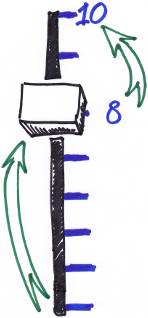Perfect Feedback
One of my favourite tools for giving and receiving feedback is the Perfection Game. It is a powerful tool to give constructive feedback in a non-threatening way. It transforms feedback from an attack or personal judgement into a constructive act of jointly improving software, articles, conference sessions, blog entries…
The Perfection Game lowers the barrier for giving feedback. It makes it much easier for me to give feedback faster and earlier, and to ask for feedback. It is useful for any situation where you want to ask or give feedback in a constructive way.
The Perfection Game is simple, but not necessarily easy and not always well understood. So how does it work?
- Someone presents their work, like a session proposal, a text, or code, and asks for feedback.
- You (the reviewer) rate the work on a scale from 1 to 10, based on how much value you can add. 10 means that the work is perfect for you. In other words, 10 means you don’t see any way in which it can be improved.
- You explain why you rated the work like you did. What makes up this number? What did you like about it? What should be kept?
- You give concrete suggestions for improvement, i.e. actions that would make the work perfect.
An example of a perfection game applied to a session proposal is:
I would give this session proposal an 8 out of 10.
What I like about it:
- catchy title, the abstract makes me want to attend
- well thought out process, seems realistic for 90 minutes
To make it perfect, I would:
- explicitly describe benefits for managers, because it would be good for the discussions to have the manager’s perspective in the room
- make the link with agile development explicit, so that it appeals to a wider audience
Some remarks:
- The rating is not a judgement, it is an indicator of how much possible improvement you see in the work.
- The Perfection Game focuses on the work instead of the person; feedback is in the eye of the beholder.
- Your improvement suggestions should be concrete and actionable; what would you do to improve the work?
It’s also great for perfectionists like me, to see the positive things and accomplishments as well ![]()
I’m co-organizer of Mini XP Days (1 April, to be announced) and XP Days Benelux (early December). We apply agile principles to organizing it, to make it an agile agile conference. We are feedback addicted and use the perfection game both during the conference, to get feedback about sessions, and in the iterative session review and improvement process, to help presenters develop quality sessions.
The Perfection Game is useful for any work product, code, text, design ideas, documents, blog entries, anything you are creating and you want to improve – it can help you get into a habit of constructive feedback and joint improvement, so that you’ll deliver better results faster.
So please do try this at home! (and work!) ![]()
Background information
- The Perfection Game is part of the Core Protocols by Jim and Michele McCarthy; I also recommend their entertaining & informative podcasts.
- The Perfection Game is similar to the scaling question from the solution focused approach.
- Perfection Game summary
- Yves Hanoulle has written an article on the Perfection Game and other Core Protocols.
- Perfection Games remove noise from developer feedback

January 27th, 2011 at 9:11 pm
Quite obvious and simple thing to try out
January 28th, 2011 at 11:56 am
What I like about this article:
- Well-explained
- Nice diagram
What would make it perfect:
- A example of what to do when your rating is 0/10 or 1/10 — i.e. you believe the idea is deeply flawed.
January 28th, 2011 at 9:49 pm
Hi David,
Thanks for your feedback! Personally I don’t encounter 1 out of 10 very often. I find that usually I can find some value, even if it’s small. Remember: if you rate something 1 out of 10, it means you see no value at all in the proposed work and you see how you can add a lot of value with helpful suggestions to move the work all the way to 10.
In the rare case that you don’t see any value nor any concrete steps to make it perfect, you’re probably the wrong person to give feedback on the work (as a conference reviewer I sometimes run into a session proposal that is completely outside my expertise and interest). Just be honest that you can’t help, or refer to someone who is better able to give feedback.
Marc